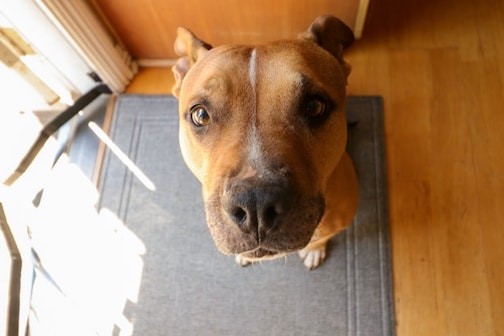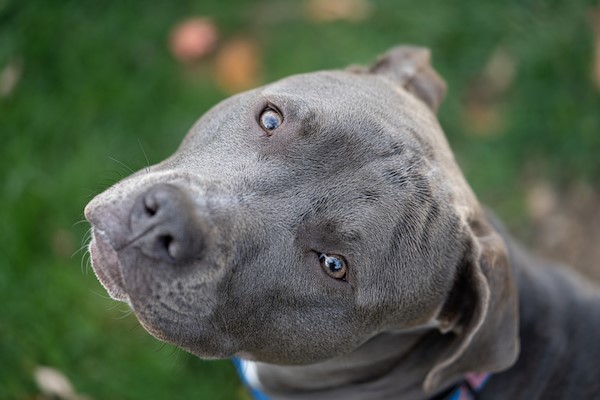Pitbull Weight and Growth Chart: Male, Female, and Puppy Growing Patterns
Posted: 08/26/2024 | BY: Humberto Noguera | Categories: Dog , Dog Weight and Growth Chart
The Pit Bull Terrier has been around for centuries, and its appearance, as well as temperament, are relatively well-defined. The Pitbull, also known as the American Pit Bull Terrier, is classified as a medium-sized dog breed with a muscular build. In the United States, the pitbull name is often unfairly associated with fear. Thus, many people rehabilitating the dog’s reputation refer to them as the Pibble. This effort is designed to spread awareness about the Pitbull’s true nature, that of loyalty, sweetness, and gentleness.
As a Pitbull pet owner, it’s essential to know the growth rates of your pup so that you can keep an eye on their weight and health. A pup’s weight and growth will differ significantly from being a week old to a month old Pitbull puppy to a Pitbull fully grown. A healthy dog becomes a happy adult dog. Early monitoring of a dog’s weight ensures that he stays healthy and does not become an underweight dog or gain weight. The correct weight is critical to the Pitbull’s growth and development.
You should be aware of the age your American Pitbull Terrier will reach full growth and how much they should weigh as they mature. This information allows you to keep tabs on your Pitbull puppy’s weight to ensure it is within an appropriate range for the breed. This knowledge gives you insight into whether your dog’s growth is an expected weight for this dog breed.

Do you own a Pitbull puppy?
If you have a Pitbull puppy in your family, you already know how sweet and loving this breed can be with people and other pets. As a Pitbull parent, you want to ensure that your pup grows up and becomes healthy. Your pup will need to hit all the healthy milestones expected of an appropriate age for a Pitbull as well, but how do you know if he’s reaching these benchmarks? You may also be wondering when does a Pitbull stop growing? What is the average Pitbull’s size? How much should a Pitbull weigh? We’ve got all the answers you need to know about Pitbull puppies’ average weight and growth in this guide.
It’s important for all Pittie parents to know what health conditions their pup may be prone to. Equally important is being financially prepared should your fur baby need medical treatment. that’s where pet insurance comes in.
Pitbull Puppy Growth Patterns: How Much Does a Pitbull Weigh?
To ensure the healthiest life possible, you must monitor your Pitbull pup closely. Keep an eye on their growth by tracking height and weight every month. Suppose they’re not meeting statistical averages for either one of those things. In that case, something could be off with the puppy’s growth rates. Growth spurts are common for Pitbull puppies. A Pitbull’s growth happens quickly, and a Pitbull’s weight can change rapidly before slowing down as they mature into adult size.
Notice that if your Pitbull puppy’s growth is slow or stunted, there may be reasons for this situation. It may be because he isn’t getting enough food, the correct type of puppy food, or may experience slow growth due to Pitbull’s genetics. Consult with the veterinarian about this. They will diagnose him to remedy the issue before permanent damage occurs.
The Pitbull’s active lifestyle means that the pet owner must carefully select the canine diet. Finding a healthy nutritional balance is essential for your puppy’s health and longevity. Proper nutrition can have lifelong effects on your Pitbull’s health and how long they will live, so finding just the right food is essential.
The Pitbull puppy is a lean, muscular animal that needs to consume the proper amount of puppy food and adequate nutrition. These elements allow them to grow and maintain their current Pitbull weight. They have moderate growth rates and require more nutrients than other types, so you must feed your pup enough calories each day.
Your dog deserves the best treatment, and that includes going to see their vet at 6 months and 12 months old. Regular checkups, especially in puppyhood, means a veterinarian can check your pup for any potential growth issues which could lead them into obesity or stunted adulthood. Your vet can also direct you to a healthy weight, proper dog food, and optimal health.
So how big will your puppy grow? Use our male and female Pitbull puppy growth chart below to track your puppy’s growth from a 3 month old Pitbull puppy size to a 6 month old Pitbull puppy size to adulthood. Then, you can make sure that your pup doesn’t experience any unexpected weight gain or loss and grows to their full potential.

Male Pitbull Growth Chart from Puppy to Adult Dog
At an average age of 12 months, a male Pitbull adult weight will typically grow to be around 15.5 inches tall and weigh between 35 – 50 pounds. By adulthood, males will grow to 18 inches tall and up to 75 pounds in adult weight.
Generally, American Pitbull Terrier males have a significant growth period between 3 and 6 months. By then, they will be at around 90% of their adult height and about 70% of their adult weight. By 12 months of age, they will be at their adult height. Still, they will continue to bulk up for another year afterward, depending on their genes and lifestyle.
American Pitbull Terriers are a muscular and medium-sized breed. Their height and weight should align with an athletic canine body type: not too heavy or too light for its height.
The Pitbull puppy weight chart below shows what healthy, appropriate weight and growth look like for Pitbull males, from average puppy weight to a Pitbull’s adult weight.
| Age | Weight |
| 1 month | 9 pounds |
| 2 months | 20 pounds |
| 3 months | 31 pounds |
| 4 months | 42 pounds |
| 5 months | 51 pounds |
| 6 months | 57 pounds |
| 7 months | 63 pounds |
| 8 months | 66 pounds |
| 9 months | 70 pounds |
| 10 months | 72 pounds |
| 11 months | 74 pounds |
| 12 months/1 year | 76 pounds |

Female Pitbull Growth Chart to Puppy to Adult
Full-grown adult female Pitbulls should be at the average height and weight for their breed, which is especially important if you plan on breeding your dog. A female Pitbull will be roughly 18 inches tall with an average of 40 to 50 pounds at 12 months of age. A full-grown female is 20 inches tall and can be as heavy as 60 pounds by maturity.
What happens if your female Pitbull becomes pregnant in adulthood?
A pregnant dog’s body undergoes significant changes during pregnancy, and the dog’s adult weight will change accordingly. A 15 – 20% weight gain is standard for most pregnant female dogs as they prepare to give birth or nurse puppies from a previous litter. The female puppy’s reproductive system is still developing, so it makes sense to avoid breeding her until she has reached maturity.
The Pitbull growth chart below displays the healthy growth patterns for a female Pitbull:
| Age | Weight |
| 1 month | 7 pounds |
| 2 months | 17 pounds |
| 3 months | 27 pounds |
| 4 months | 36 pounds |
| 5 months | 44 pounds |
| 6 months | 50 pounds |
| 7 months | 54 pounds |
| 8 months | 58 pounds |
| 9 months | 60 pounds |
| 10 months | 62 pounds |
| 11 months | 63 pounds |
| 12 months | 64 pounds |

When Do Pitbulls Stop Growing?
The Pit Bull is a medium-sized, muscular dog. It takes time to grow into adulthood, and some dogs may not reach the full height or weight for up to one year, depending on their bone structure. That’s one reason why tracking your puppy’s developmental milestones during their first year of life is critical to their lifelong health. Pitbulls typically stop growing between 12 – 15 months of age. Expect that your Pitbull puppy’s height, weight, and general size will change radically during the first year of the pup’s life. Use our Pitbull weight chart to guide you during your dog’s puppyhood.

Is Your Pitbull Healthy?
Pitbulls are one of the most popular breeds in America, and for a good reason. Their friendly demeanor and loyal nature towards their pet parents make them an ideal family pet. These dogs will love life with you as much as they do your other furry friends.
Your Pitbull is your furkid, and you want to make sure they’re happy. The best way to do that would be to prevent any illnesses or health problems before it’s too late. Preventive care will always work in favor of those pups whose pet owner has been proactive with their vet visits instead of reactive. Like any other dog, Pitbulls are susceptible to various health issues, the most common of which are listed below.
Hip Dysplasia
Canine hip dysplasia, or CHD, causes dogs pain and makes it difficult for canines to move freely. Dogs suffering from this issue have a shallow hip socket of their hips combined with an improper fit of the femur ball (“femoral head”). Suppose the femur ball and the hip socket don’t fit together. In that case, the hip’s cartilage wears away, resulting in initially mild to intensely uncomfortable pain. CHD is also responsible for arthritis within the hip, which worsens as the adult Pitbull grows older.
Dogs with CHD can develop joint instability as they age. This malformation occurs when the surrounding ligaments and muscles that support those joints don’t hold together over time due to deterioration or injury from various other sources, like genetics and environmental stressors. Unfortunately, the Pitbull is more susceptible to developing this painful and debilitating condition.
Kneecap Dislocation (Luxating Patella)
Patellar luxation is a condition where the kneecap (patella) has slipped out of its normal position. Laterally, that can happen towards one side and not touching anything on that leg. It may also occur medially when it moves away from being centered toward the opposite leg instead.
With the kneecap dislocated medially, the dog’s knee cannot extend properly and is bent. Sometimes the kneecap will naturally move back into place after the dog takes a few steps. However, in severe cases, surgery is the only viable option to improve the dog’s quality of life. Pitbulls are one of the breeds more likely to have congenital kneecap dislocation.

Degenerative Myelopathy
The American Pitbull Terrier is commonly diagnosed with degenerative myelopathy. This disease causes progressive loss of nerve function due to an inherited mutation in their SOD1 gene. Research shows that Pitties develop this condition through genetic or environmental elements. This disease affects the spinal cord and acts similarly to Lou Gehrig’s disease in humans.
As the Pitbull grows older, degenerative myelopathy initially appears as muscle atrophy and loss of coordination. Although this medical condition rarely causes the dog pain, it will eventually prevent the dog from walking altogether.
Congenital Heart Defects
The Pitbull is prone to heart disease and may suffer from aortic stenosis when there is too much pressure on the left ventricle. This issue can cause shortness of breath or chest pains due to its narrowing size. The Pitbull has a higher risk of developing health conditions such as heart disease. A veterinarian can quickly diagnose an irregular heartbeat or murmur by simply listening to the dog’s heart.

Have a Pitbull? Protect them with pet insurance.
Your Pitbull might be the best dog in town, but he still needs your love and care. You cannot control the genes passed down from generation to generation to your pup. However, a responsible pet parent will prepare as much as possible for potential health issues in their dog’s future. Preparing for the unexpected is crucial to ensuring your dog has everything they need during emergencies. What if cancer happens? Or if your dog is hit by a car? How will you cover the expensive surgery and medication bills?
Investing in pet insurance is ideal for protecting your dogs from unforeseen accidents or illnesses. A quality policy will cover the majority of emergency procedures and medication costs. An insurance policy is a great way to protect your furry friend from any accidents that he may get into. Get a free instant quote for the type of coverage you need, and protect your Pitbull for life.
Disclaimer
The information contained on this blog is intended for informational and educational purposes only and should not be construed as medical advice. It is not a substitute for professional veterinary care. Always consult with your veterinarian before making any changes to your pet's health care or treatment plan.
The authors of this blog are not veterinarians and do not claim to be experts in pet health. The information provided here is based on our own experiences and research, as well as information from reputable sources. However, we cannot guarantee the accuracy or completeness of this information.
We encourage you to do your own research and consult with your veterinarian before making any decisions about your pet's health.
Compare top pet insurance providers & plans.
Enter your dog’s age in years and months to calculate their age equivalent to human years.
Calculate your dog’s ageEnter your cat’s age in years and months to calculate their age equivalent to human years.
Calculate your cat’s age